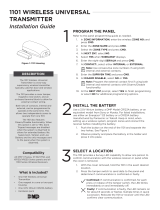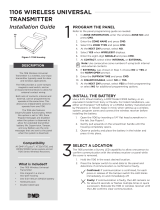La page est en cours de chargement...

1
Door/Window & Long Life Door/Window Sensors
ITI Part Nos. 60-362 & 60-641
Document Number: 466-1022 Rev. D PRELIMINARY
October 2000
8867g01a.ds4
Product Summary
The Door/Window Sensor (60-362) and Long Life Door/
Window Sensor (60-641) can be installed on doors, win-
dows, or virtually anything that opens and closes. During
normal operation, the sensors transmit open (TRIP) and
close (RESTORE) signals to the panel. The sensors also
send a supervisory signal to the panel every 64 minutes.
Sensors transmit open and close signals to the panel when a
magnet (mounted near the sensor) is moved away from or
closer to the sensor.
The sensors are powered by a 3.6-volt lithium battery.
The Long Life Door/Window Sensor battery cannot be
replaced by installers or users. If you receive a low
battery report, you must return the sensor to ITI for
replacement.
Tools Needed
q#6 flathead screws or 18-gauge brads
qScrewdriver or brad driver
qSmall wire cutters
qSensor and magnet spacers (optional)
Installation Guidelines
qKeep all sensors within 100 feet of the panel.
qMount the sensor on the door frame and the magnet on
the door. If the sensor is to be used on double doors,
mount the sensor on the least used door and the magnet
on the other door.
qMount sensors with screws or brads, not double-sided
tape.
qPlace sensors at least 5 inches above the floor to avoid
damaging them.
qUse spacers (not included) to keep sensors and magnets
away from metal or metallic surfaces such as foil wall-
paper.
Door/Window Sensor Spacers
White: ITI Part #60-189
Brown: ITI Part #60-191
Magnet Spacers
White: ITI Part #60-188
Brown: ITI Part #60-190
qRemove the internal reed switch not being used.
qAvoid mounting sensors in areas with a large quantity
of metal or electrical wiring, such as a furnace or utility
room.
qAvoid mounting sensors in areas where they will be
exposed to moisture.
qAvoid mounting sensors in locations where the operat-
ing temperature (10° to 120° F) will be exceeded.
Do not remove the jumper from the Long-Life Door/
Window Sensor circuit board! The sensor cannot work
without the jumper.
Installation
You must be free of all static electricity when handling
electronic components. Touch a grounded, bare metal
surface before touching a circuit board or wear a
grounded wrist strap.
1. Decide if the sensor should be mounted horizontally or
vertically by locating the alignment marks on the sen-
sor and magnet plastic (see Figure 1.)
The marks indicate reed switch locations. Each sensor
uses only one of the two switches. You will remove the
unused one in step 4.
Figure 1. Alignment marks
2. Remove the sensor cover by squeezing the cover ends
firmly to release the tab on the cover from the slot on
the sensor base.
3. Remove the circuit board from the sensor base by pull-
ing back the plastic tab and lifting the battery to release
the circuit board.
SENSOR END VIEW SENSOR SIDE VIEW
MAGNET
ALIGNMENT MARKS
ALIGNMENT MARK
8867G03A.DS4
'RRU:LQGRZ/RQJ
/LIH'RRU:LQGRZ
6HQVRUV

2Door/Window & Long Life Door/Window Sensors
Connecting External Switches
4. Remove the unused reed switch, clipping the leads as
close to the board as possible (see Figure 2.)
Figure 2. Door/Window Sensor Circuit Boards
5. Mount the sensor base with screws or brads. Use spac-
ers to compensate for metal surfaces or height varia-
tions.
6. Remove the magnet from its base. Mount the magnet
base no more than 3/8 inches away from the sensor
base (see Figure 3). Replace magnet cover.)
Figure 3. Mounted Sensor and Magnet
Mount the magnet so it won’t interfere with door or
window openings. Do not use two-sided tape.
7. Reattach the circuit board to the sensor base.
8. Reattach the sensor cover to the sensor base.
Connecting External Switches
Door/window sensors can be connected to either normally
open (close on alarm) or normally closed (open on alarm)
external switches. Wire multiple, normally closed switches
in series. Wire multiple, normally open switches in parallel.
Do not attempt to use the built-in reed switches and an
external switch on the same door/window sensor. For high
security installations, always remove both reed switches
when connecting an external switch to the sensor terminals.
In UL listed installations, only the normally closed con-
figuration can be used.
Materials Needed
qHermetically sealed external switches (sealed reed
switch) that supply a minimum 250-millisecond open
or closure on alarm.
qStranded 22-gauge wire.
qInstallation Guidelines
qDo not use solid core wire.
qDo not use mechanical switches.
TA M PER SW ITC H
TERM INALS
CIRCUIT
BOARD
H O LD IN G TA B
REED SW ITCHES
8867G 05A .D S F
3.6 V O LT
1/2 A A B A TTE R Y
M O D E L 60-362
JUM PER
TA M PER SW ITC H
TERM INALS
CIRCUIT
BOARD
H O LD IN G TA B
REED SW ITCHES
3.6 VOLT AA BATTERY
8867G 04C .D S F
M O D E L 60-641
DOOR DOOR FRAME
MAGNET SENSOR
8867G02A.DS4
ALIGNMENT MARKS

3
Door/Window & Long Life Door/Window Sensors
Programming
qIf you are connecting a remote device to a door/win-
dow sensor, do not use the built-in reed switches.
qDo not connect fast pulse devices (such as Window
Bugs) to door/window sensors.
qDo not use more than 25 feet of 22-gauge, stranded
wire in any wire run.
qDo not use more than 6 feet of untwisted wire in any
wire run.
qDo not connect more than five switches or more than
one alarm screen to a door/window sensor.
qDo not run wires parallel to electrical wires. If you
can’t avoid a parallel wire run, keep it at least 18 inches
away from electrical wiring.
qIf necessary, you may cross electrical wires at a 90
degree angle.
Programming
The following steps describe the general guidelines for pro-
gramming (learning) the sensor into panel memory. Refer to
the specific panel installation instructions or reference man-
ual for complete programming details.
1. Set the panel to the program mode.
2. Proceed to the LEARN SENSORS menu.
3. Select the appropriate sensor group and sensor number
assignments.
4. Set the external switch (if one is connected) in the
alarm condition (open for normally closed circuits;
closed for normally open circuits).
5. Trip the sensor’s tamper switch by removing the sensor
cover.
6. Exit program mode.
7. Place the cover back on the sensor.
Testing
The following steps describe the general guidelines for test-
ing the sensor. Refer to the specific panel installation
instructions or reference manual for complete testing
details.
1. Set the panel to the dealer sensor test mode.
2. Trip the sensor.
3. Listen for interior siren beeps to indicate how many
rounds the panel receives from the sensor. You should
hear 6 to 8 beeps.
Notes on Testing the LongLife Door/
Window Sensor
The Long Life Door/Window Sensor has a built-in power-
saver feature that turns on automatically when the sensor is
tripped more than once, within a 4-1/4 minute time period.
When the power-saver feature is on, the sensor transmits
only half the usual number of data rounds when tripped. For
example, during a dealer sensor test you normally expect to
hear up to 8 data rounds. When the power-saver feature is
on, you may hear only up to 4 data rounds.
To be sure the sensor has acceptable transmitting range to
the panel, leave the sensor undisturbed in the closed (non-
alarm) condition for 5 minutes before tripping it for testing.
This gives the sensor enough time to turn off the power-
saver feature so you can get accurate sensor test results.
Specifications
Operating Temperature Range: 0° to 120° F.
Compatibility: All Learn Mode panels
Power Source: 1/2 AA 3.6-volt lithium battery for 60-362,
AA 3.6-volt lithium battery for 60-641
Transmit Range: At least 500 feet, open air
Notices
FCC Part 15 Information to the User
Changes or modifications not expressly approved by Interactive Technolo-
gies, Inc. can void the user’s authority to operate the equipment.
FCC Part 15 Class A
This equipment has been tested and found to comply with the limits for a
class A digital device, pursuant to part 15 of the FCC rules. These limits
are designed to provide reasonable protection against harmful interference
when the equipment is operated in a commercial environment.
This equipment generates, uses, and can radiate radio frequency energy
and, if not installed and used in accordance with the instruction manual,
may cause harmful interference to radio communications. Operation of
this equipment in a residential area is likely to cause harmful interference
in which case users will be required to correct the interference at their own
expense.
FCC Part 15 Class B
This equipment has been tested and found to comply with the limits for a
Class B digital device, pursuant to part 15 of the FCC Rules. These limits
are designed to provide reasonable protection against interference in a resi-
dential installation.
This equipment generates, uses, and can radiate radio frequency energy
and, if not installed and used in accordance with the instructions, may
cause harmful interference to radio communications. However, there is no
guarantee that interference will not occur in a particular installation.
If this equipment does cause harmful interference to radio or television
reception, which can be determined by turning the equipment off and on,
the user is encouraged to try to correct the interference by one or more of
the following measures:
Reorient or relocate the receiving antenna.
Increase the separation between the equipment and receiver.
Connect the affected equipment and the panel receiver to separate
outlets, on different branch circuits.
Consult the dealer or an experienced radio/TV technician for help.
/




